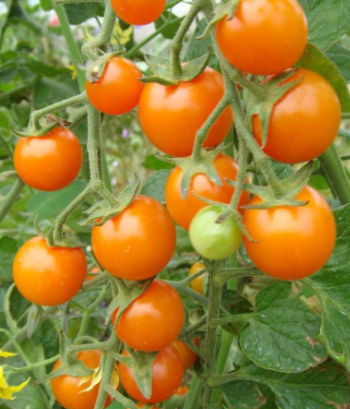Click below to listen to my 2 min. Garden Bite radio show: GMOs vs hybrids
Hybridizing, genetically modified and genetically engineered. Hmm, is there a difference? Hooo, boy, this is a big topic and it won’t be answered here but there are distinctions on HOW plants are modified.
Modifications aka genetic mutations take place in every living thing naturally. When 2 people have a baby, there’s some mutation going on. Not sure that’s real romantic but, I hope, you catch my drift.
This tomato ‘Sungold’ was bred for disease resistance and flavor. It is an F1 hybrid.

Hybridizers have been modifying plants since agriculture began, it used to take 6 to 10 generations to change characteristics. Modern hybridization speeds up that process considerably. Using a method of controlled crossing devised by Charles Darwin and Gregor Mendel in the mid-19th century, plant breeders can now produce seed that combines the desired traits of two pure parent lines in the first generation. This creates a new variety known as an “F1 hybrid.” To create F1 seed, seed companies grow two parent lines in the field each year, designate the male and female parents, carry out pollination under controlled conditions such as hand-pollination under row cover and then harvest seed from the females.
Click HERE for a great article from Mother Earth News explaining this form of plant breeding much more fully. Here’s another pdf from a website called nongmoproject. I found it interesting. GMO Myths and Truths. FarmAid on GM or GE
I just have to add this close-up. This petunia lasted all season, even in heat. Again, it’s an F1 hybrid.
Genetically Modified (GMO) varieties are created in a lab using highly complex technology, such as gene splicing. These high-tech GM varieties can include genes from several species?—?a phenomenon that almost never occurs in nature. It includes the introduction of a bacteria into a plant for specific pest resistance. Another way to explain this is to say that a GMO could cross a plant with a fish. Two completely different species.
Click HERE for an article from Pacific Standard The Science of Society saying that scientists say GMO’s are safe. From US News and World Report: GMO’s are nothing to fear and the FDA on GMO’s
 Here’s the caveat to most of the proponents of GMO’s. They are likely associated with major corporations that are pumping millions of dollars into this technology. I’m not going to say ALL GMO’s are bad, frankly, I don’t know. But the scary part is, neither does anyone else. It takes years and years of research to discover the ramifications of what we do. As we’ve all witnessed through the years, here are a couple of minor ones. Butter’s bad, no it’s not. High cholesterol is bad, well unless it’s HDL. Or how about tobacco? Or sugar substitutes?
Here’s the caveat to most of the proponents of GMO’s. They are likely associated with major corporations that are pumping millions of dollars into this technology. I’m not going to say ALL GMO’s are bad, frankly, I don’t know. But the scary part is, neither does anyone else. It takes years and years of research to discover the ramifications of what we do. As we’ve all witnessed through the years, here are a couple of minor ones. Butter’s bad, no it’s not. High cholesterol is bad, well unless it’s HDL. Or how about tobacco? Or sugar substitutes?
There’s a lot of money at stake here and each side can go to extremes to make their point, and they do. It would be great to have a conversation without politics, money or fear involved.


